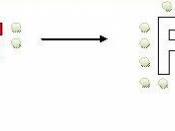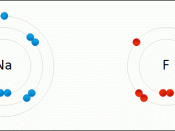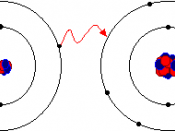Chemical bonds are what make up the world. In bonds, elements are held together and form compounds that may have new physical and chemical properties. There are two main kinds of bonds, they ionic and covalent. In bonding the goal of the atoms involved is to reach a level of stability with less energy. In order to reach the epitome of stability, as in the case of noble gases, an atom strives to complete its outer shell. Either losing or gaining electrons may do this, which concludes in an ionic bond or the sharing of electrons with other atoms which makes a covalent bond.
Ionic bonds, as you can probably surmise form from ions. Ions are made when an atom gains an electron to form a negative ion or loses an electron to form a positively charged ion. As an example of an ionic bond let's used the elements Cl and Na.
First, we must understand that there is an attraction between them because one is positive and the other negative and that the Cl atom contains seven valence electrons and Na one. So, as the atoms bond the Na loses its valence electron and Cl gains it making its outer shell complete and it more stable. During this reaction light and heat are given off. This shows an exothermic reaction, which is a release of energy. The electrostatic energy between the two holds them together. Ionic bonds are useful because in a liquid state it can conduct electricity. This is possible because it contains ions. That doesn't conduct electricity in the solid state because there is not enough room within the molecule. The substance produced by this bond is table salt. Other salts, such as CaCl (rock salt) are formed in the same way and although they have a...


